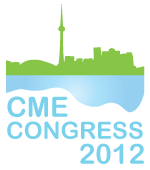Leticia Lorier (EviMed); Alvaro Margolis (EviMed); Elisa Martínez (EviMed); Thais Forster (EviMed); Antonio López (EviMed)
Synopsis
“EMC en Red” (meaning CME network) is a professional community for those working in CME and CPD, who organize and carry out educational activities for health professionals in Latin America. The purpose of this community is to build capacity through the exchange of experiences, discussion of literature and collective reflection, understanding learning as a collaborative social process.
Purpose
There is a need for those professionals in Latin America working on CME and CPD to overcome isolation and stay updated in this domain. EviMed is a CME Company with headquarters in Uruguay; it is interested in having its interdisciplinary teams knowledgeable about the latest developments, as well as fostering bonds with institutions and professionals working on CME across the region. Therefore, a community of practice was promoted.
Methods
In order to design the interventions, in February 2011 CME professionals known to the group were invited to participate in the community and asked about their needs and topics of interest.
The community was based on:
1. Monthly meetings, simultaneously onsite and via internet conferencing. 2. Professional exchange between the meetings via a virtual campus.
3. Literature review and sharing of experiences.
Results
There has been a monthly meeting from March to September 2011, and two more meetings are planned before the southern hemisphere summer break.
The topics addressed have varied, ranging from CME effectiveness to experiences in blended learning or massive CME interventions for emerging infectious diseases.
Presenters have been from Uruguay, Argentina, Puerto Rico and USA. There have been active participants in the meetings from these countries and Mexico, Paraguay, Peru, Spain and Italy. There has been a rather stable number of participants along the year, ranging from 15 to 26 attendants from 5 to 12 institutions coming from 3 to 5 countries at a time. Nevertheless, it has been a challenge to keep participants interested, since participation is on a voluntary basis, event by event.
Conclusion
The goals established when this project started have been realized. Furthermore, several organization from the region decided to support this initiative. Still, this is a never-ending process that has just started.
This initiative was primarily funded by EviMed, and supported by the Uruguayan Honorary Cancer Commission and by GlaxoSmithKline.
Funding Sources
This initiative was primarily funded by EviMed, and supported by the Uruguayan Honorary Cancer Commission and by GlaxoSmithKline.





